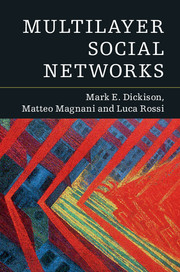Book contents
- Frontmatter
- Dedication
- Contents
- list of abbreviations
- 1 Moving Out of Flatland
- PART I MODELS AND MEASURES
- PART II MINING MULTILAYER NETWORKS
- 4 Data Collection and Preprocessing
- 5 Visualizing Multilayer Networks
- 6 Community Detection
- 7 Edge Patterns
- PART III DYNAMICAL PROCESSES
- PART IV CONCLUSION
- Glossary
- Bibliography
- Index
5 - Visualizing Multilayer Networks
from PART II - MINING MULTILAYER NETWORKS
Published online by Cambridge University Press: 05 July 2016
- Frontmatter
- Dedication
- Contents
- list of abbreviations
- 1 Moving Out of Flatland
- PART I MODELS AND MEASURES
- PART II MINING MULTILAYER NETWORKS
- 4 Data Collection and Preprocessing
- 5 Visualizing Multilayer Networks
- 6 Community Detection
- 7 Edge Patterns
- PART III DYNAMICAL PROCESSES
- PART IV CONCLUSION
- Glossary
- Bibliography
- Index
Summary
As early as the eleventh century of our era, triangular houses were universally forbidden by Law.
– The SquareVisualization has two main goals: it can be used as an exploratory tool to gain a basic understanding of the network structure and of some network properties, for example, the presence of communities, or it can be used to present the results of a preexisting analysis in an easily accessible way. In both cases, good visualizations can play an important role in a SNA process. However, although today it is relatively easy to produce beautiful network diagrams using one of the many SNA software packages, producing insightful diagrams can be more challenging, especially when the network is large. We can emphasize many aspects while visualizing a social network, and some of them may create visual noise and hide other properties. Not surprisingly, when multilayer social networks are involved, these aspects are even more important. Therefore, in this chapter, we present different visualization approaches and exemplify them on our running example to highlight the kind of information that they can extract from a real multilayer network.
Four Main Approaches
There are two main aspects where visual representation of social networks can play a major role: the visualization of network structure, that is, the spatial disposition of its nodes and edges, and a visual representation of its numerical properties, corresponding to the various metrics that exist in SNA or to those described in Chapter 3. These two kinds of goals can also be merged into a single visualization, either by augmenting a graph with information about the metrics or using the metrics to remove irrelevant information from the graph. We have illustrated these four approaches in Figure 5.1, as described in the following.
Among the visualizations focusing on the network structure, graphs and their application to social networks, known as sociograms (Moreno, 1934), have seen, so far, themostwidespread adoption (von Landesberger et al., 2011).
This adoption has been so large and diffuse that outside of academic discourse, SNAand sociograms are sometimes perceived as synonyms. An example of this is the sociogram of the lunch layer in the AUCS network, shown in Figure 5.1a.
Information
- Type
- Chapter
- Information
- Multilayer Social Networks , pp. 79 - 95Publisher: Cambridge University PressPrint publication year: 2016
Accessibility standard: Unknown
Why this information is here
This section outlines the accessibility features of this content - including support for screen readers, full keyboard navigation and high-contrast display options. This may not be relevant for you.Accessibility Information
- 3
- Cited by
